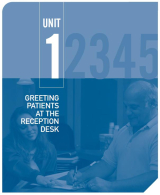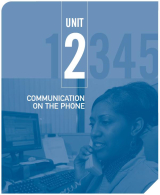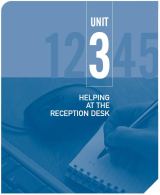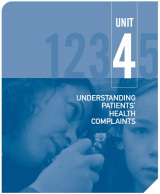
Oups, this website is outdated! But Dialogue McGill has a new website!
The self-study workbook and accompanying audio and video documents present a variety of scenarios based on typical situations involving medical receptionists and clients. Language learners who view the videos, listen to the audio exercises and complete the workbook exercises will learn to use appropriate English terms in order to do the following:

Functions |
- Greeting people - Taking personal information - Giving directions - Asking someone to clarify when you don't understand |
Listening |
- To a dialogue for general comprehension - To numbers, telephone numbers, addresses - To reasons why a patient comes in - To a dialogue for personal information to fill out a form |
Vocabulary |
- Directions and prepositions of place |
Grammar |
- Imperatives - Simple present |
Cultural Note |
- Greeting people |
Communication Strategies |
- Global understanding |

Functions |
- Greeting people on the phone - Being polite on the phone - Making suggestions and recommendations - Booking appointments - Discussing possibilities - Interrupting politely |
Listening |
- To a dialogue for general comprehension - To a dialogue of specific expressions of politeness - To a dialogue to give directions - To a dialogue to make an appointment - To a dialogue to take personal information |
Vocabulary |
- Numbers - Dates - Days - Times - Polite expressions |
Grammar |
- Ordinal numbers - Prepositions for time - Modals or politeness and suggestion - Degrees of comparison of adjectives - Future |
Cultural Note |
- People's names |
Communication Strategies |

Functions |
- Helping an anxious patient with admission forms - Identifying problems and providing solutions - Identifying vocabulary in a reading passage |
Listening |
- To a scenario at the reception desk for general comprehension and for pronunciation - To admission form vocabulary |
Vocabulary |
- Admission form vocabulary - Phrasal verbs - Directional phrasal verbs |
Grammar |
- Phrasal verbs - Simple present - Present continuous |
Cultural Note |
- Addressing patients by name |
Communication Strategies |

Functions |
- Reviewing terms of discomfort - Responding to various health problems |
Listening |
- To a dialogue for general comprehension - To helpful statements and questions - To the pronunciation of: body parts; aches and pains; health problems |
Vocabulary |
- Body parts - Aches and pains - Respiratory problems - Skin conditions - Musculoskeletal problems - Gastrointestinal problems - Genitourinary problems |
Grammar |
- Simple past - Past continuous |
Cultural Note |
- Talking about the body |
Communication Strategies |
- Checking understanding/hypothesis testing |

Functions |
- Responding in difficult situations/difficult people - Expressiong empathy - Delivering bad news - Describing emergency symptoms - Asking about symptoms |
Listening |
- To a dialogue for general comprehension - To general complaints - To physical and emotional complaints - To pronunciation of medical terms and symptoms |
Vocabulary |
- Words expressive of feelings - physical/emotional states - Expressions of pain - Idiomatic expressions - Medical personnel - Medical symptoms |
Grammar |
- Comparative form of adjectives - Conjunctions - Phrasal verbs |
Cultural Note |
- Understanding emotional patients - Identity and emotions - Non-verbal communication |
Communication Strategies |
- Understanding situations |
![]() audio2.1norm-noiseremoval.mp3
audio2.1norm-noiseremoval.mp3
Audio - Checking Information on the Phone
Comprehension exercise [.pdf]
In, On and At for Time [.pdf]
Practice with In, On, At and No Preposition [.pdf]
More Polite Practice [.pdf]
![]() 1_helping_an_anxious_patient.m4v
1_helping_an_anxious_patient.m4v
Video - Helping an Anxious Patient
Vocabulary [.pdf]
Something to Think About | Helping Mrs. MacIntosh [.pdf]
Cultural Note and Vocabulary Boost [.pdf]
Admission Form Vocabulary [.pdf]
Communication Strategies: Inferencing [.pdf]
Cultural Notes - Understanding Emotional Patients [.pdf]
You can gain access to complementary exercises by clicking on a specific unit.
Unit 1
Unit 2
Unit 3
Unit 4
Unit 5